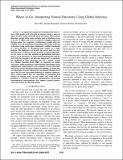Where to go: Interpreting natural directions using global inference
Author(s)
Wei, Yuan; Brunskill, Emma; Kollar, Thomas Fleming; Roy, Nicholas
DownloadWei-2009-Where to go Interpreting natural directions using global inference.pdf (559.5Kb)
PUBLISHER_POLICY
Publisher Policy
Article is made available in accordance with the publisher's policy and may be subject to US copyright law. Please refer to the publisher's site for terms of use.
Terms of use
Metadata
Show full item recordAbstract
An important component of human-robot interaction is that people need to be able to instruct robots to move to other locations using naturally given directions. When giving directions, people often make mistakes such as labelling errors (e.g., left vs. right) and errors of omission (skipping important decision points in a sequence). Furthermore, people often use multiple levels of granularity in specifying directions, referring to locations using single object landmarks, multiple landmarks in a given location, or identifying large regions as a single location. The challenge is to identify the correct path to a destination from a sequence of noisy, possibly erroneous directions. In our work we cast this problem as probabilistic inference: given a set of directions, an agent should automatically find the path with the geometry and physical appearance to maximize the likelihood of those directions. We use a specific variant of a Markov Random Field (MRF) to represent our model, and gather multi-granularity representation information using existing large tagged datasets. On a dataset of route directions collected in a large third floor university building, we found that our algorithm correctly inferred the true final destination in 47 out of the 55 cases successfully followed by humans volunteers. These results suggest that our algorithm is performing well relative to human users. In the future this work will be included in a broader system for autonomously constructing environmental representations that support natural human-robot interaction for direction giving.
Date issued
2009-05Department
Massachusetts Institute of Technology. Computer Science and Artificial Intelligence LaboratoryJournal
IEEE International Conference on Robotics and Automation, 2009. ICRA '09
Publisher
Institute of Electrical and Electronics Engineers
Citation
Yuan Wei et al. “Where to go: Interpreting natural directions using global inference.” Robotics and Automation, 2009. ICRA’09. IEEE International Conference on. 2009. 3761-3767. © 2009 IEEE.
Version: Final published version
ISBN
978-1-4244-2788-8
ISSN
1050-4729